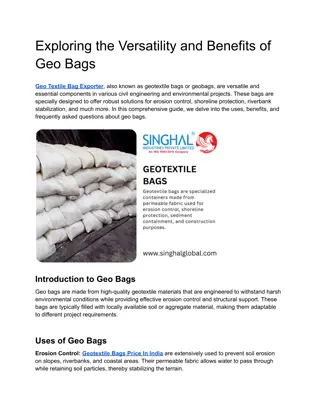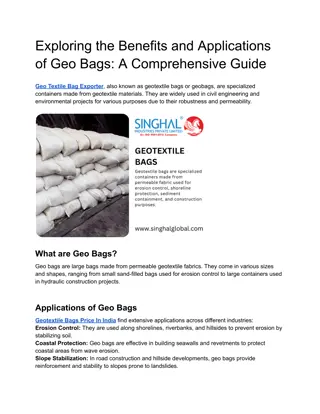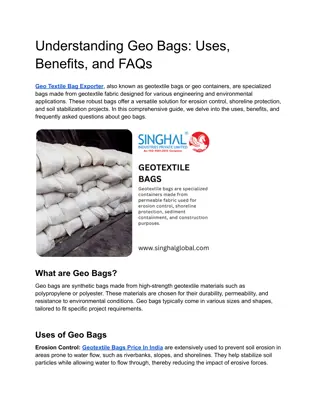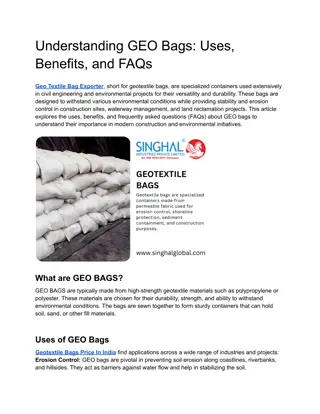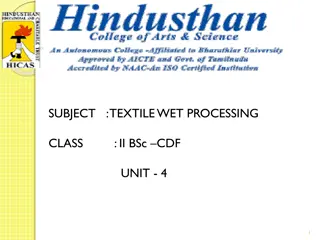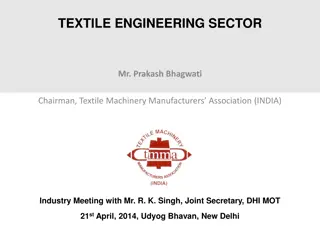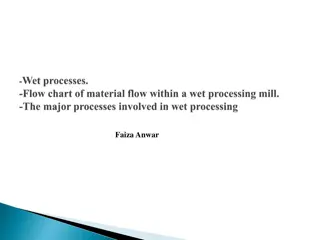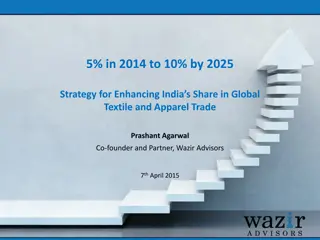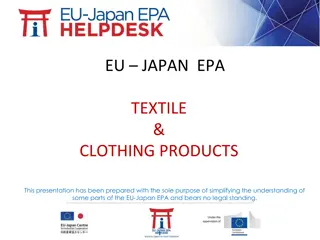Phase Change Materials in Textile Finishing Technology
Phase change materials (PCMs) play a vital role in storing, releasing, and absorbing heat in textiles. This process involves substances transitioning between solid and liquid states, offering thermal energy benefits. PCMs like waxes such as Eicosane and Octadecane have specific melting points to maintain a comfortable body temperature range. Fibers, fabrics, and foams embedded with PCMs are used for designing all-season outfits that adjust to varying climatic conditions. Understanding the dynamic nature of phase change in textiles helps optimize comfort and performance.
Download Presentation

Please find below an Image/Link to download the presentation.
The content on the website is provided AS IS for your information and personal use only. It may not be sold, licensed, or shared on other websites without obtaining consent from the author.If you encounter any issues during the download, it is possible that the publisher has removed the file from their server.
You are allowed to download the files provided on this website for personal or commercial use, subject to the condition that they are used lawfully. All files are the property of their respective owners.
The content on the website is provided AS IS for your information and personal use only. It may not be sold, licensed, or shared on other websites without obtaining consent from the author.
E N D
Presentation Transcript
Hindusthan College of Arts & Science An Autonomous College- Affiliated to Bharathiar University Approved by AICTE and Govt of Tamilnadu Accredited by NAAC- An ISO Certified Institution Class: III Class: III BSc BSc COSTUME DESIGN COSTUME DESIGN &FASHION &FASHION SUBJECT:TEXTILE FINISHING SUBJECT:TEXTILE FINISHING TECHNOLOGY TECHNOLOGY
Online Class (Google Meet): Prepared by Deepa.V Date:05.09.2021, Class : III BSc CDF PHASE CHANGE FINISH PHASE CHANGE FINISH Phase change is the process of going from one physical state to another i.e. from solid to liquid. Substances that undergo the process of phase change are better known as Phase Change Materials (PCM). These material stores, release or absorb heat as they oscillate between solid and liquid form. They give off heat as they change to a solid state and absorb as they return to liquid state. The three fundamentals Phases of a matter solid, liquid and gas.
Online Class (Google Meet): Prepared by Deepa.V Date: .05.09.2021, Class : III BSc CDF Phase Change Materials are compounds, which melts and solidify at certain temperature and in doing so are capable of storing or releasing large amount of energy. The storage of thermal energy by changing the phase of material at a constant temperature is called latent heat, that is, changing from a liquid state to solid state. When a PCM undergoes a phase change a large amount of energy is required.
Online Class (Google Meet): Prepared by Deepa.V Date: 05.09.2021, Class : III BSc CDF Some of these PCMs change phase within a temperature range just above and below human skin temperature. This property of certain substance is used for making protective all season outfits, and for abruptly changing climatic conditions. Fibre, fabric and foam with built-in PCMs store the warmth of body and then release it back to the body, as it needs it. Since the process of phase change is dynamic, the material are constantly changing from a solid to liquid and back depending upon level of physical activity of the body and outside temperature.
Online Class (Google Meet): Prepared by Deepa.V Date: 05.09.2021, Class : III BSc CDF Phase change materials are waxes that have the unique ability to absorb heat energy and emit heat energy without changing temperature themselves. These waxes include Eicosane, Octadecane, Nonadecane, Heptadecane and Hexadecane. They all have different freezing and melting points and when combined in a microcapsule will store heat energy and emit heat energy and maintain their temperature range of 30-34C, which is comfortable for the body.
Online Class (Google Meet): Prepared by Deepa.V Date: 05.09.2021, Class : III BSc CDF How to incorporated PCMs into Fabric How to incorporated PCMs into Fabric? ? The micro encapsulated PCM can be combined with woven, non-woven or knitted fabrics. The capsules can be added to the fabric in many ways such as: Microcapsules of different shapes-round, square and triangular within fibres at the polymer stage. The PCM microcapsules are permanently locked within the fibre structure during the wet spinning process of fibre manufacture. Micro encapsulation provides a softer hand, increased stretch, more breath ability and air permeability to the fabrics.
Online Class (Google Meet): Prepared by Deepa.V Date: 05.09.2021, Class : III BSc CDF Matrix coating onto fabrics during finishing: the PCM microcapsules are embedded in a coating compound like acrylic, polyurethane, etc. and applied to the fabric. There are various coating processes available such as knife-over-roll, knife-over-air, pad-dry-cure, gravure, dip coating, and transfer coating. Foam dispersion: Microcapsules are mixed into a water-blown polyurethane foam mix and these foams are applied fabric in a lamination process water is taken out of the system by drying process.
Online Class (Google Meet): Prepared by Deepa.V Date: 05.09.2021, Class : III BSc CDF PCM microcapsules can produce small, temporary heating and cooling effects in garment layers when the temperature of the layers reaches the PCM transition temperature. The effect of phase change material on the thermal comfort of protective clothing systems will be maximized when the wearer is repeatedly going through temperature transients (i.e., going back and forth between a warm and cold environment) or intermittently 'touching or handling cold objects.
Online Class (Google Meet): Prepared by Deepa.V Date: 05.09.2021, Class : III BSc CDF How does it work In Fabrics? When the encapsulated PCM is heated to the melting point, it absorbs heat energy as it moves from a solid state to a liquid state. This phase change produces a temporary cooling effect in the clothing layers. The heat energy may come from the body (e.g. when the wearer first dons the garment) or from a warm environment. Once the PCM has completely melted the storage of heat stops.
Online Class (Google Meet): Prepared by Deepa.V Date: 05.09.2021, Class : III BSc CDF If the PCM garment is worn in a cold environment where the temperature is below the PCM's freezing point and the fabric temperature drops below the transition temperature, the micro encapsulated liquid PCM will change back to a solid state. Generating heat energy and a temporary warming effect Application on PCM Automotive textiles: Automotive textiles: During the summer, the temperature inside the passenger compartment of an automobile can rise substantially -- for instance, when the car is parked outside. In order to stabilise the interior temperature while driving the car, many models are equipped with air conditioning systems; however, providing sufficient cooling capacity required a lot of energy. Thus, the use of Phase Change Material technology in different applications for automotive interior could supply energy savings as well as increasing the thermal comfort of car interior.
Online Class (Google Meet): Prepared by Deepa.V Date: 05.09.2021, Class : III BSc CDF Apparel active wears: Active wear needs to provide a thermal balance between the heat generated by the body while engaging in a sport and the heat released into the environment. Normal active wear garments do not always fulfill this requirement. Lifestyle apparel: Lifestyle apparel: smart fleece vest, mens and womens hats, gloves and rainwater. Outdoor sports apparel: Outdoor sports apparel: jackets and jacket linings, boots, golf shoes, running shoes, socks, and ski and snowboard gloves. From original applications in space suits and gloves, Phase Change Materials are finding their way into consumer product.
Online Class (Google Meet): Prepared by Deepa.V Date: 05.09.2021, Class : III BSc CDF Aerospace textiles: Phase Change Materials found in today's consumer products originally were developed for use in space suits and gloves to protect astronauts from extreme temperature fluctuations while performing extra-vehicular activities in space. Medical textiles: Medical textiles: Textiles containing Phase Change Materials (PCMs) could soon find uses in the medical sector To increase the thermo-physical comfort of surgical clothing such as gowns, caps and gloves. In bedding materials such as mattress covers, sheers and blankets. A product, which supports the effort to keep the patient warm enough during an operation by providing insulation tailored to the body's temperature.
Online Class (Google Meet): Prepared by Deepa.V Date: 05.09.2021, Class : III BSc CDF MCQ MCQ https://docs.google.com/forms/d/e/1FAIpQLSd8ye_CXXPMEGu7s2Afmba w-PtIDHT0yfd7JT0YUAro-XiGlw/viewform?usp=sf_link



